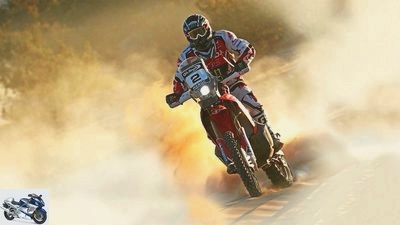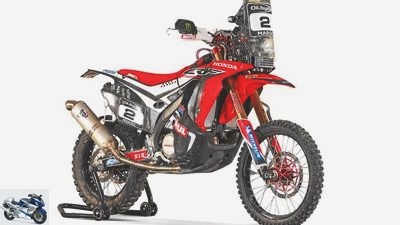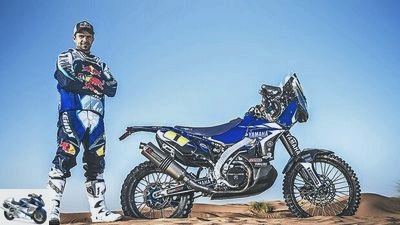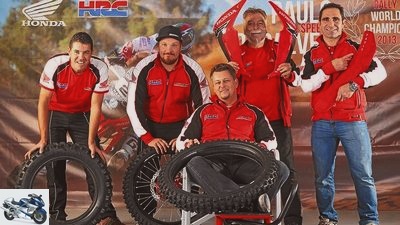Table of contents
- Presentation Dakar-Honda To a good new one
- Developed by Honda Racing Corporation (HRC) in Japan
- At first glance, the appearance of the Honda was hardly changed
- The sensation: single cylinder with two overhead camshafts
- The rally
- The team

Honda
Sports & scene
Motorsport
Sport: Presentation Dakar-Honda
Presentation Dakar-Honda
To a good new one
Honda’s rally comeback at the 2013 Dakar went badly wrong. Shortly after the turn of the year, the motorcycle giant wants to rehabilitate itself in the largest of all desert rallies – with a brand new machine.
Peter Mayer
December 19, 2013
It would have been a success story that only the world’s largest motorcycle manufacturer could have written. 24 years after the last triumph at the Dakar Rally, Honda decided to make a comeback in rallying, upgraded the sport enduro CRF 450 X to make it suitable for the desert, hired a handful of rally experienced drivers – and finally won. But the 2013 Dakar rewrote the script. Stage victories were out of the question, and the best Honda rider, the Portuguese Helder Rodrigues, only ended up in seventh place.
Buy complete article

Presentation Dakar-Honda
To a good new one
4 pages) as PDF
€ 2.00
Buy now
Developed by Honda Racing Corporation (HRC) in Japan
Obviously, those responsible for Honda had seriously underestimated the technical level in rallying after the long period of abstinence. Or, as some desert racing insiders put it more succinctly: The CRF 450 Rally was too unstable, too heavy and too weak. In this respect, the Japanese had no choice but to press the reset button for the next Dakar edition, which starts on January 5, 2014. “We have hardly taken over an element from the previous machine,” says project manager Katsumi Yamazaki, describing the new start. However, he does not reveal any details about the new CRF 450 Rally, and there are few people who know about it. The desert racer is developed and built entirely at the Honda Racing Corporation (HRC) at the headquarters in Japan. Nevertheless, the highly decorated racing department does not dare to handle the enormous logistical effort of the world’s most famous desert rally on its own. Instead of relying exclusively on the services of the Dutch HT Honda Rally Raid team as they did on the previous Dakar, the Japanese are relying on a second mainstay for the upcoming desert tour: the Speedbrain team based in Stephanskirchen near Rosenheim.
This rallying accolade comes at just the right time for the six-man company around mastermind Wolfgang Fischer. Just three weeks after star driver Joan Barreda brilliantly staged the team starting on Husqvarna with four stage wins at the last Dakar, the parent company BMW sold the northern Italian manufacturer to KTM. Since then, the manufactory has continued its rally involvement with Husky technology on its own and brought five handcrafted machines to customers for the upcoming Dakar. At the same time, Bayern have been fully integrated into the Honda project since the middle of the year. With resounding success: when the new Honda was launched at the Morocco Rally at the end of October, the Speedbrain delegation and the second driver, the Portuguese Paulo Gonçalves, clinched victory.
At first glance, the appearance of the Honda was hardly changed

Bilski
Even if the look was largely taken over from the previous year’s model – under the outer shell there is a completely redesigned engine and a heavily redesigned frame.
As if the Bavarians wanted to preserve the latest triumph like a talisman, the new CRF 450 Rally is still in the workshop with the dusty patina of the successful Dakar dress rehearsal. Visually, the Honda has hardly changed at first glance, it still impresses with its impeccable workmanship. The transparent front panel, a high-gloss surface and quick-release fasteners give the prototype an almost mass-produced, almost polished finish. Everything is new under the cover, too, if not necessarily spectacular. The chassis continues to adopt the aluminum bridge frame that has long been common in motocross sport. It can be assumed that the wheelbase, which was two centimeters longer than the enduro model last year, has grown again in favor of better high-speed stability. The tanks of the new ones have also been modified and are visibly slimmer in the lower area. The resulting reduced volume compensates for the completely redesigned rear. Instead of a subframe with two fuel tanks screwed on at the sides, the rear frame now consists of a self-supporting carbon fiber monocoque.
This solution has three advantages. Firstly, the rear with the integrated tank is much narrower, secondly, the fuel supply shifted to the rear helps to relieve the heavy front of rally cars, and thirdly, the gasoline is much closer to the center of gravity of the machine. Ultimately, this change should profoundly change the driving behavior of the CRF.
The sensation: single cylinder with two overhead camshafts
The real sensation of the 2014 rally Honda is hidden behind the front tanks, which were not allowed to be dismantled in public – and also for the MOTORRAD studio photos: the single-cylinder with two overhead camshafts. Basically, this valve control, which is widespread in the majority of motorcycle engines, is anything but exceptional. The issue only becomes explosive against the background that Honda has been singing the high song of the compact Unicam valve train since the introduction of its new four-stroke engine generation in off-road sports in 2002, even if the lower-displacement models in particular have struggled with this concept in terms of performance since then . The dohc head should therefore give the injection-fed 450 single, especially at higher speeds, more power. The absolute performance values of a rally engine are kept within limits. For the sake of durability, the designers limit themselves to a peak performance of just over 60 hp, because the exchange of engines is only permitted under penalty.
There is a 15-minute surcharge for the first engine change, 45 minutes for the second and two hours for the third.
Perhaps this aspect is precisely the reason for another novelty on the rally Honda. The wheel speed sensors on the front and rear wheels indicate that the HRC crew is using traction control for the first time in rallying. Adjusted accordingly, the slip control could help to avoid speed peaks when the rear wheel is briefly relieved without losing the technical advantages of power drift in loose terrain. The durability of the tires could also benefit from the reduced slip. On two marathon stages, the drivers are not allowed to seek outside help or change tires in the evening.
But all of this must initially remain speculation. On the other hand, it is clear that Honda is serious about the second attempt after the moderate success at the comeback. The new desert ship should be around ten kilograms lighter with a full tank of 162 kilograms and around ten kilometers per hour faster than the previous model with a top speed of 175 km / h. From a marketing perspective, winning the most popular of all desert rallies would of course be a precision landing. This means that the Reds could celebrate the 25th anniversary of their last victory at the Dakar in 1989 as befittingly as the planned presentation of the new Honda Africa Twin. Or will it be called the South America Twin?
The rally

KTM
Defending champion Cyril Despres is highly motivated after switching from KTM to Yamaha.
When the Dakar convoy rolls 8,700 kilometers through South America for the sixth time from January 5 to 18, 2014, very few fans will mourn the African roots of this desert hunt. The backdrop with an audience of millions and impressive landscapes is too imposing. Especially since the upcoming Dakar edition will be on Bolivian soil for the first time alongside the slopes of the traditional host countries Argentina and Chile.
In terms of sport, the orientation of this Dakar will be sharpened, especially for motorcyclists. The 181 bikers will have to cope with 40 percent of the special stages on routes that are separate from the cars and are much more demanding in terms of driving. A challenge that two German pilots also accept. While Jorg Majoli (53) from Puttlingen in the Saarland is realizing his dream of participating in the Dakar for the first time, Bayer Ingo Zahn (50) can draw on his experience at three Dakar starts so far.
The battle for victory, however, will take place among around a dozen factory drivers. While the five Honda drivers can initially operate without a stable order, the leaders with Marc Coma at KTM and the defending champion Cyril Despres, who surprisingly switched from the Austrians to Yamaha this year, have clearly been determined.
The TV broadcaster Eurosport will report on the rally. A summary of each stage is planned for 11 p.m. on the same evening.
The team

Bilski
Giants of the desert.
A total of five factory drivers will compete for Honda at the upcoming Dakar. While Helder Rodrigues (P), Sam Sunderland (UAE) and Javier Pizzolito (ARG) will be integrated into the Dutch HT Honda Rally Raid team, the German Speedbrain team will look after Joan Barreda (E), who is considered a potential Dakar winner, and the reigning driver World rally champion Paulo Gonçalves (P / on the photo on the right). The men around team boss Wolfgang Fischer (seated) competed at the Dakar 2013 as the official Husqvarna works team and – with Barreda in the saddle – won four stages. After the sale of the Italian manufacturer, the extremely professional Bavarians continued the project with their own Speedbrain 450 Rally.
Related articles
-
Sport: MotoGP – driving report Kalex-Moto2
Photo 2snap motorcycles Sport: MotoGP – driving report Kalex-Moto2 Sports MotoGP – driving report Kalex-Moto2 Just four months before the premiere of the…
-
BMW HP2 Sport, the production of the sports boxer has been discontinued.
Jahn motorcycles BMW HP2 Sport, the production of the sports boxer has been discontinued. The BMW HP2 Sport Production discontinued: BMW HP2 Sport BMW…
-
Comparison test: BMW HP2 Sport, Buell 1125R
fact motorcycles Comparison test: BMW HP2 Sport, Buell 1125R Comparison test: BMW HP2 Sport, Buell 1125R Exotic bonus Content of That was the surprise…
-
Presentation of the Zongshen ZS 750
motorcycles Presentation of the Zongshen ZS 750 Presentation of the Zongshen ZS 750 The fight with the dragon The Zongshen ZS 750 is the first big bike…
-
Sport: Kreidler van Veen 50 cc racing machine
Nakamura motorcycles Sport: Kreidler van Veen 50 cc racing machine Sport: Kreidler van Veen 50 cc racing machine circular saw Content of If you want to…
-
Mitas Sport Force + EV with multi-compound
Mitas accesories tire Mitas Sport Force + EV with multi-compound Mitas Sport Force + EV Update of the Sport Force + with a new mixture With two new…
-
Restoration of Moto Guzzi Le Mans I and Moto Guzzi V7 Sport
Siemer 24 pictures Siemer 1/24 Two Le Mans I and a V7 Sport in original and museum condition. Siemer 2/24 Reinhard Backer doing the freestyle. Freehand….
-
Approvals for the new sport touring tire Conti Road Attack 3
Continental 14th pictures markus-jahn.com 1/14 Picture gallery: Touring tires 120/70 ZR 17 and 180/55 ZR 17 in the test. markus-jahn.com 2/14 After…
-
Sport: Superbike World Championship Lausitzring
Felix Wiessmann Sports & scene Motorsport Sport: Superbike World Championship Lausitzring Sport: Superbike World Championship Lausitzring Watered down…
-
Presentation of the Victory Core concept bike
Victory 12th pictures Victory 1/12 Victory Core concept bike Victory 2/12 Victory Core concept bike Victory 3/12 Victory Core concept bike Victory 4/12…